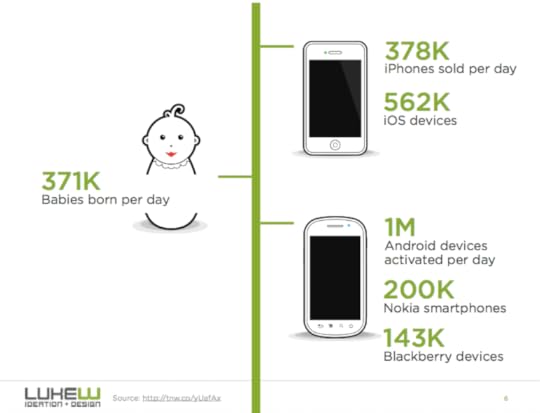Jeffrey Zeldman's Blog, page 52
July 21, 2012
My mind and welcome to it

IN MY DREAM I was designing sublime new publishing and social platforms, incandescent with features no one had ever thought of, but everybody wanted.
One of my platforms generated pages that were like a strangely compelling cross between sophisticated magazine layouts and De Stijl paintings. Only, unlike De Stijl, with its kindergarten primary colors, my platform synthesized subtle color patterns that reminded you of sky and water. Anyone – a plumber, a fishmonger – could use the tool to immediately create pages that made love to your eyes. In the hands of a designer, the output was even richer. Nothing on the web had ever touched it.
Then the dream changed, and I was no longer the creator. I was a sap who’d been off sniffing my own armpits while the internet grew up without me. A woman I know was using the platform to create magazines about herself. These weren’t just web magazines, they were paper. And they weren’t just paper. In the middle of one of her magazines was a beautiful carpet sample. The platform had designed the carpet and woven it into the binding of the printed magazine. I marveled at her output and wished I had invented the platform that allowed her to do these things. Not only was I no longer the creator, I seemed to be the last sap on earth to even hear about all these dazzling new platforms.
Then I was wandering down an endless boardwalk, the sea on my right, a parade of dreary seaside apartment buildings on my left. Each building had its own fabulous content magazine. (“Here’s what’s happening at 2171 Oceanfront Walk.”) The magazines appeared on invisible kiosks which revealed themselves as you passed in front of each building. The content, created by landlords and realtors, was so indifferent as to be unreadable. But this did not matter a bit, because the pages so dazzled in their unholy beauty that you could not look away. Every fool in the world had a meaningless publication which nobody read, but which everyone oohed and ahed at as they passed. And I — I had nothing to do with any of it. I was merely a spectator, a chump on a tiresome promenade.
For Tim and Max. You are the future.
July 18, 2012
Tweak This!
99designs, the Australian company that has made a fortune soliciting spec work (“crowd sourced graphic design”) from naive designers, and selling $99 logo customizations to small businesses, has just invested $460,000 in a new service:
Tweaky, “the marketplace for website customization,” is the ultimate connector between companies that need quick, simple adjustments to their websites, and designer/developers seeking extra income via no-brainer side work.
The premise is simple: Want to add a subscription come-on to your site but don’t know the first thing about HTML, and don’t have the budget to hire a designer or studio? Tweaky will change your site for $25. Need to update the copyright information in your footer, but don’t know how to do it? Tweaky will handle it for you for $25. Need to add a sidebar to your website? Tweaky will do it for $25. Cheeseburger, cheeseburger, cheeseburger.
Tweaky sounds like the perfect service for the harried small business owner who needs to make one or two quick adjustments to an existing website, has limited time and means, and needs the changes to be made professionally. The last bit is most important: there’s a difference between hiring a designer to make your logo bigger, and doing it yourself when you’re not a designer, don’t own Photoshop, aren’t expert in HTML and CSS, and so on. Tweaky’s promise is that only qualified designer/developers will be hired to make your $25 tweaks. My guess is that, at least initially, Tweaky will draw on the same community that currently participates in 99designs’s “design contests” (spec work), or at least it will solicit designers from that pool.
Crowd sourcing design is unethical (read Design Is A Job and Design Professionalism if you’re unfamiliar with the standards of conduct in a professional designer/client relationship—or, for now, just read this tweet, and read these two great books later), so I disapprove of 99designs, but its new child appears to have been born sinless. While some designers, possibly including the authors of the aforementioned texts, will dislike the notion of Tweaky on principle, I don’t think designers or studios will lose customers to a $25 tweak service. I don’t think it’s exploitation to accept $25 to change a link in a footer (assuming the designer gets the bulk of the fee). And I don’t think a client with an existing website should have to pay several thousand dollars engaging a designer simply to make a wee adjustment to her site. Tweaky offers customers access to real designers for quick jobs, and offers designers a work and revenue stream. That seems okay to me.
Caveat emptor: I haven’t hired Tweaky (no need), don’t know how they evaluate designer/developers before admitting them to their freelance labor pool, don’t know how much of a customer’s $25 ends up in a designer’s pocket, and can’t speak to the quality of their concierge service and follow-through. But I find their business model unobjectionable and intelligent—it fills a designer’s need for extra work and a customer’s need for quick turnaround on no-brainer mini-projects. Truth to tell, I’ve heard talk of similar networks in the works, and would not be surprised to see competitors to Tweaky sprout up soon enough. It’s the economy, smarty.
July 16, 2012
Come out and see me.
IF YOU MISSED An Event Apart Austin, you can still see me speak about web and interaction design and the future of web content at one of these fine events near you:
An Event Apart DC
August 6–8, 2012
An Event Apart Chicago
August 27–29, 2012
Refresh LX, Lisbon, Portugal
September 20–21, 2012
Future of Web and Mobile – London
October 15-17, 2012
An Event Apart San Francisco
November 12–14, 2012
Inspire Conference, Leiden, The Netherlands
December 9–12, 2012
Keep up with my comings and goings on Lanyrd, follow me on Twitter (@zeldman) and Facebook (professional, personal), and keep watching the skies at An Event Apart, the design conference for people who make websites.
July 9, 2012
An Event Apart Austin 2012
FOLLOW THE ACTION at An Event Apart Austin – three days of design, code, and content for people who make websites, now taking place in Austin, TX.
A Feed Apart
Just the tweets.
Content First
“In his opening keynote at An Event Apart in Austin, TX 2012 Jeffrey Zeldman talked about the need to keep content front and center in websites and the web design process.” Enjoy Luke Wroblewski’s notes on my presentation, “Content First.”
Responsive Design Workflow
“In her presentation at An Event Apart in Austin, TX 2012 Sarah Parmenter talked about the changes responsive web design requires of web designers.” Enjoy Luke Wroblewski’s notes from her talk on “Responsive Design Workflow.”
On Web Typography
Jason Santa Maria “outlined the current state of web fonts and how to approach typography online.” Luke Wroblewski’s notes on the talk.
Mobile To The Future
My notes on Luke Wroblewski’s AEA Austin presentation.
Content Strategy Roadmap
“In her Content Strategy Roadmap presentation at An Event Apart in Austin TX 2012 Kristina Halvorson talked about how to integrate content strategy into a typical web design workflow.” Enjoy Luke Wroblewski’s notes from her talk.
Conference Photos
Enjoy the Flickr pool of photos from the three-day web design conference event now being held in Austin, TX.
Watch this space!
More to come.
Mobile to the Future
Notes on Luke Wroblewski’s “Mobile To The Future” presentation today at An Event Apart Austin:
First there was print, then recordings, then cinema, radio, TV, and the internet. Mobile is the seventh and latest form of mass media. And the smartphone is the fastest spreading technology in history. More iPhones are activated every day than babies are born.
Can mobile do what print did? What recordings did? What cinema did? What radio did? What TV and the internet did? Yes, mobile can do all of it. It also has unique properties: always with you, always on, built-in payment mechanism, at point of inspiration, accurate audience, captures social context, augmented reality, digital interface to reality.
When new mass media comes out, we try to apply old thinking to it. We treated early TV like radio (sponsors, jingles, spokesmen, programs). Radio shows migrated whole to early TV (Abbott & Costello, Lone Ranger, etc.) It took many years to realize that TV was not radio. Likewise, we still have ingrained print characteristics impacting how we think about web and mobile. (Page/canvas, grid layouts, typography, graphical ads.) As many people will tell you — but not many people practice — the web is not print.
Mobile is not desktop. “Copy, extend, and finally, discovery of a new form. It takes a while to shelf old paradigms.” – Scott Jensen
Companies are discovering they can do more on mobile. People are 2x more likely to buy on mobile; 2.5x more likely to subscribe; 3x more likely to be engaged. Don’t just look at the *constraints* of mobile; look at the opportunities.
Outline of remainder of talk: What we know from the desktop web; how to adapt and optimize for mobile; ways to move forward.
Consider login. People do at least 15 authentications per day. 82% of people have forgotten a site password. 5%-10% of people trying to access Yahoo fail to log in (and request password). The number one problem at help desks is, “Help, I forgot my password.” Login is a ubiquitous, but broken, system. We have brought all the problems of desktop login to the mobile platform, where problems are magnified. On Amazon, they removed “I forgot my user ID or password” from login to “save space” in mobile context. Result: 90% of their customer service calls were “I forgot my password.” Removing critical functionality is not a good way forward.
“Guest Checkout” is a popular feature on many commerce sites that increases conversion. You’d think this feature, which boosts conversions 30%, would be carried over to mobile. But Walmart.com omitted it. Instead they told the user to get a desktop computer.
“Mobile must never be a dumbed-down, limited experience,” says Steven Hoober.
Don’t remove critical features!
Do get rid of autocomplete and autocapitalize on login and password inputs.
Do use types (“type=password”) to facilitate sign-in.
Do show passwords; password masking results in login failures and lost opportunities.
Show passwords. (Give people the option to “Hide password” in case they need it.)
Use Input Masks on login, e.g. start “user name” fields with an “@” symbol. On MobileMe, there was an “@me.com” input mask in the user email address input screen (since you needed an @me.com address to be able to sign in anyway).
Quora doesn’t ask for your password immediately; first it checks to make sure you’ve entered your email address correctly.
One-tap operation: the second time you visit Quora, you can enter simply by tapping your avatar picture.
Third-party credentials (“sign in with Facebook”) cause problems, because users don’t remember if they created an account or signed in with Twitter/Facebook. Bagcheck and Votizen use a pattern where you begin typing your name and a series of selects show up, allowing you to pick your name from the list. Once it knows your name, the app gives you the chance to log in via your internal account or a third-party apps.””’
Summary so far
Don’t remove critical features.
Use input types and attributes.
Show password by default.
If possible, save people’s passwords so they can log in with one click.
Next time the user signs up, let them enter by tapping their avatar.
These techniques don’t just benefit mobile users. They also benefit those who use desktop, tablet, and God knows what’s coming next.
July 4, 2012
A July Fourth Message

HAPPY ORDINARY DAY to my friends in Afghanistan, Albania, Algeria, Andorra, Angola, Antigua and Barbuda, Argentina, Armenia, Australia, Austria, Azerbaijan, Bahamas, Bahrain, Bangladesh, Barbados, Belarus, Belgium, Belize, Benin, Bhutan, Bolivia, Bosnia and Herzegovina, Botswana, Brazil, Brunei , Bulgaria, Burkina Faso, Burma, Burundi, Cambodia, Cameroon, Canada, Cape Verde, Central African Republic, Chad, Chile, China, Colombia, Comoros, Congo, Costa Rica, Cote d’Ivoire, Croatia, Cuba, Cyprus, Czech Republic, Denmark, Djibouti, Dominica, Dominican Republic, East Timor, Ecuador, Egypt, El Salvador, Equatorial Guinea, Eritrea, Estonia, Ethiopia, Fiji, Finland, France, Gabon, Gambia, Georgia, Germany, Ghana, Greece, Grenada, Guatemala, Guinea, Guinea-Bissau, Guyana, Haiti, Holy See, Honduras, Hong Kong, Hungary, Iceland, India, Indonesia, Iran, Iraq, Ireland, Israel, Italy, Jamaica, Japan, Jordan, Kazakhstan, Kenya, Kiribati, Kosovo, Kuwait, Kyrgyzstan, Laos, Latvia, Lebanon, Lesotho, Liberia, Libya, Liechtenstein, Lithuania, Luxembourg, Macau, Macedonia, Madagascar, Malawi, Malaysia, Maldives, Mali, Malta, Marshall Islands, Mauritania, Mauritius, Mexico, Micronesia, Moldova, Monaco, Mongolia, Montenegro, Morocco, Mozambique, Namibia, Nauru, Nepal, Netherlands, Netherlands Antilles, New Zealand, Nicaragua, Niger, Nigeria, North Korea, Norway, Oman, Pakistan, Palau, Palestinian Territories, Panama, Papua New Guinea, Paraguay, Peru, Philippines, Poland, Portugal, Qatar, Romania, Russia, Rwanda, Saint Kitts and Nevis, Saint Lucia, Saint Vincent and the Grenadines, Samoa , San Marino, Sao Tome and Principe, Saudi Arabia, Senegal, Serbia, Seychelles, Sierra Leone, Singapore, Slovakia, Slovenia, Solomon Islands, Somalia, South Africa, South Korea, South Sudan, Spain, Sri Lanka, Sudan, Suriname, Swaziland, Sweden, Switzerland, Syria, Taiwan, Tajikistan, Tanzania, Thailand , Timor-Leste, Togo, Tonga, Trinidad and Tobago, Tunisia, Turkey, Turkmenistan, Tuvalu, , Uganda, Ukraine, United Arab Emirates, United Kingdom, Uruguay, Uzbekistan, Vanuatu, Venezuela, Vietnam, Yemen, Zambia, and Zimbabwe.
June 29, 2012
Responsive Typography
“NOT EVERYTHING always works in your favor when you design for the screen. Interaction design is engineering: it’s not about finding the perfect design, it’s finding the best compromise.”
June 28, 2012
Facebook goes native
“IF I WERE advising them on these decisions, I would have had them look at what people actually want from Facebook — fast access to their friends’ photos and posts — and … helped them design an HTML5 web experience that actually works for mobile.”
.net magazine: Facebook iPhone app to go native By Tanya Combrinck on June 28, 2012
June 20, 2012
Responsive and Mobile Now
A FEW GOOD LINKS from a day-long workshop by Luke Wroblewski:
The EMs have it: Proportional Media Queries FTW! by Lyza Gardner
Responsive IMGs Part 2 — In-depth Look at Techniques by Jason Grigsby
Multi-Device Layout Patterns by Luke Wroblewski
by Jason Weaver
Responsive Video Embeds with FitVids by Dave Rupert
RESS: Responsive Design + Server Side Components by Luke Wroblewski
RESS, Server-Side Feature-Detection and the Evolution of Responsive Web Design by Dave Olsen
June 19, 2012
Interacting Responsively (and Responsibly!)
AT AN EVENT APART Boston, “Scott Jehl discussed ways we can improve web performance by qualifying capabilities and being smart about how assets are loaded in browsers [and] shared a … new tools he helped create that can help address these issues.”
Enjoy Luke Wroblewski’s notes on Scott’s talk.







